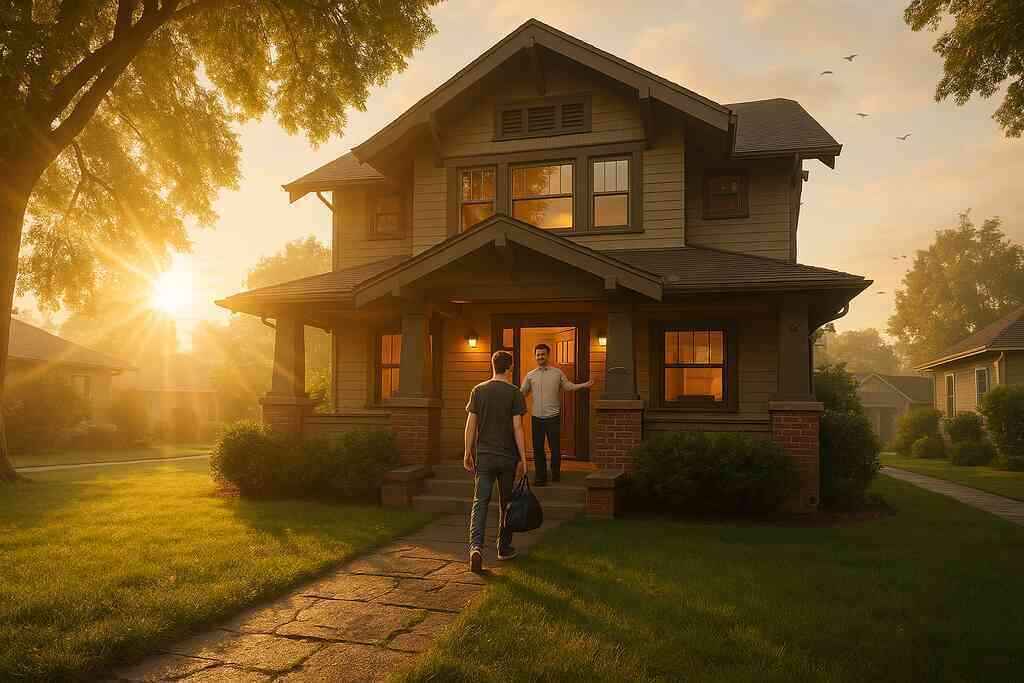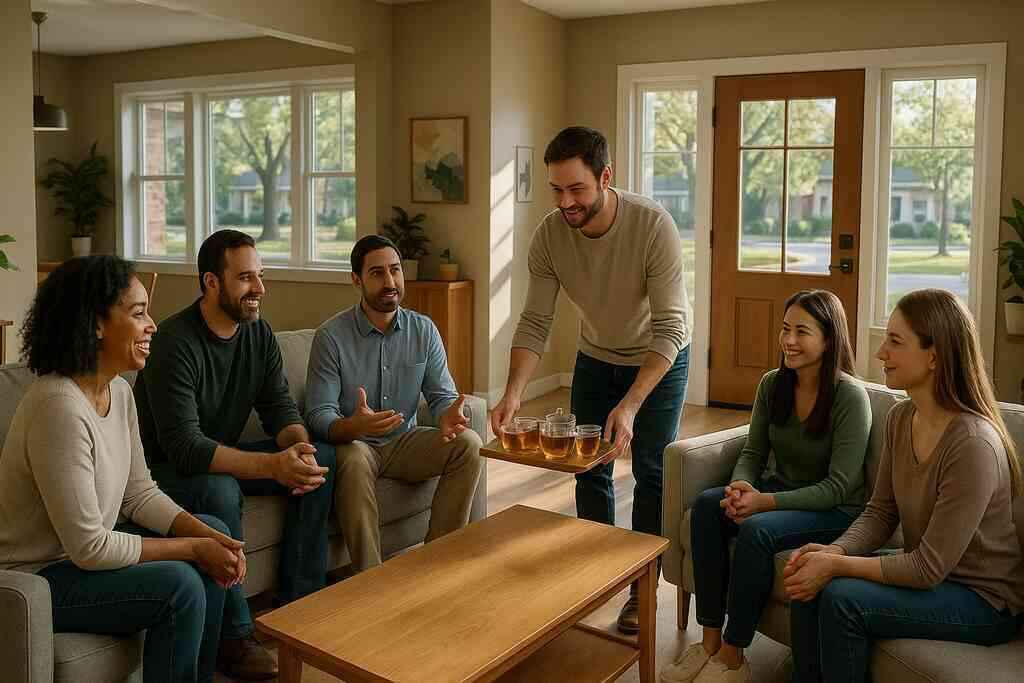
Exploring the Definition of a Safe Environment at Top Sober House
November 28, 2025
Opening the Door to Recovery: Understanding Safety at Top Sober House
From inpatient treatment to structured sober living houses
Transitioning from inpatient treatment to structured sober living houses can feel daunting, yet it marks a pivotal point in the recovery journey. Clinical settings shield clients from outside triggers, but real-world sobriety demands practice in a supervised, substance-free home. Top Sober House narrows that gap by pairing professional guidelines with peer support, ensuring the leap never feels like a free fall. Individuals searching the directory can instantly search for secure sober homes near you and evaluate each listing’s safety metrics.
A structured sober living environment layers accountability on top of personal freedom. Curfews, house meetings, and mandatory 12-step attendance weave recovery routines into the resident’s daily life. Each rule has a therapeutic purpose: it restricts opportunities for relapse while encouraging time management, employment, and self-care. The resulting rhythm mirrors mainstream living but removes alcohol and drug availability, creating a strong bridge between treatment programs and full independence. Over time, residents internalize these habits, transforming external rules into internal resilience.
What a truly safe sober living environment looks like in early recovery
During the first twelve months of sobriety, safety requires more than locked doors; it needs built-in relapse prevention. Top Sober House insists on drug-free zoning, exterior lighting, and secure entry systems, but the gold standard rests on predictability-random drug testing, curfews, and a clear grievance process. Healthy predictability lowers anxiety, a leading relapse driver, and helps residents focus on therapy goals rather than worrying about hidden substances. For deeper insight, review the blueprint titled Defining a Safe Space at Top Sober House.
Emotional safety matters just as much as physical safeguards. Trauma-informed staff validate feelings without judgment, mediating conflicts before they escalate. House meetings invite residents to voice concerns, fostering psychological ownership of the space. Peer accountability networks form naturally as people draft relapse prevention plans together, share 24/7 phone trees, and celebrate milestones. This layered protection gives newcomers the confidence to focus on therapy, employment, and rebuilding family ties.
How house rules transform group homes into a secure sober house near you
Rules often get a bad reputation, yet in sober housing they operate as the invisible rails keeping the recovery train on track. Curfew adherence, mandatory chores, and visitor restrictions reduce chaos, thereby lowering relapse probability. Consistent enforcement by a live-in house manager ensures fairness and prevents residents from slipping through accountability gaps. Readers curious about rule effectiveness can study the top features boosting long-term sobriety that emerge from nationwide data.
Effective house policies also set clear consequences paired with restorative opportunities, balancing firmness with compassion. For example, a failed drug screen triggers an immediate safety plan and referral to outpatient treatment rather than reflexive eviction. This approach protects the community while keeping the individual engaged in care. Regular policy reviews incorporate resident feedback and evolving best practices, demonstrating that safety is not a static checkbox but an ever-improving system designed for long-term sobriety success.
Structural Pillars Physical and Community Safeguards
Physical architecture cannot stand without solid footings; neither can a safe sober living environment exist without deliberate safeguards. At Top Sober House, safety moves beyond marketing language and becomes an operational blueprint woven into every property. These structural pillars combine neighborhood analysis, relapse-resistant design, and trauma-informed protocols. They ensure each resident of sober living homes can focus on the recovery journey instead of mere survival. Strong transition from inpatient treatment to community life requires predictable rules, peer support, and immediate crisis coverage. Therefore, the following subsections unpack how top sober houses transform good intentions into measurable security.
Neighborhood safety assessments and drug free zoning
Every address considered by Top Sober House undergoes a rigorous neighborhood safety assessment long before a lease is signed. Planners study crime statistics, lighting patterns, bus routes, and proximity to liquor stores to uncover hidden relapse triggers. Municipal partners confirm that the property qualifies for drug-free zoning, protecting residents from hostile businesses or unsafe traffic. Clients reviewing listings for drug-free sober living in Massachusetts can see these metrics displayed transparently, reinforcing trust through data. By publicizing numbers instead of promises, top sober homes establish accountability to families and referral professionals alike.
Environmental scanning continues after move-in, because communities shift and new threats appear. A designated house manager conducts monthly walks with residents, noting broken streetlights, suspicious activity, or construction that alters traffic flow. Findings funnel into an action log reviewed during house meetings, ensuring peer support fuels collective vigilance. This living document exemplifies house rules enforcement, showing residents that safety is everyone’s daily responsibility. Over time, the practice builds civic engagement and models how graduates maintain a sober environment once they secure apartments.
Built in relapse resistant design and secure entry protocols
Structural engineering inside top sober houses mirrors clinically tested relapse-prevention theory. Bedrooms are intentionally modest, reducing isolation and encouraging communal life in shared lounges. Secure entry systems require biometric or coded access, preventing unauthorized visitors who might smuggle alcohol or drugs. Cameras cover exterior doors but avoid private spaces, balancing dignity with deterrence. The result is a physical landscape that reminds every resident that long-term sobriety is the core mission.
Interior flow patterns also discourage impulsive drug abuse. Kitchen cabinets lock after curfew, and communal refrigerators prohibit caffeinated energy drinks linked to insomnia. Soft lighting, sound-absorbing materials, and calming color palettes reinforce a supportive environment proven to lower cortisol. Importantly, maintenance schedules follow hospital standards, eliminating mold or clutter that can trigger depression in early recovery. Such design choices elevate top sober house safety beyond the norms of traditional halfway houses.
Emergency response procedures and trauma-informed sober care
Even with perfect architecture, emergencies happen, and preparedness distinguishes top sober houses near you from average group homes. Each property posts evacuation maps, weather-specific contingency plans, and local emergency numbers in every hallway. Staff rehearse fire drills quarterly, documenting completion for state compliance and insurance audits. Naloxone kits and automatic external defibrillators remain accessible, with the house manager trained to deploy them within seconds. These physical safeguards create a safe place where residents can concentrate on 12-step meetings instead of worst-case scenarios.
However, emergency planning without emotional intelligence can retraumatize people overcoming substance use disorder. Therefore, Top Sober House mandates trauma-informed sober care woven through every procedure. Staff debrief residents after alarms, allowing feelings to surface and normalizing stress reactions. They also coordinate with outpatient program clinicians and support groups to refine individualized coping plans. By coupling technical readiness with compassionate practice, top sober houses prove safety means protecting both body and mind in tandem.

The Human Shield Screening Accountability and Peer Support
Resident screening process to prevent substance use disorder triggers
Top Sober House begins safety at the front door through a rigorous resident screening process that surpasses many halfway houses. Background checks, clinical assessments, and personal interviews verify readiness for a sober living environment before admission. In some regions, applicants can preview similar criteria by exploring structured recovery housing in Georgia, illustrating transparent standards. Staff also review medication lists to detect potential complications with substance use disorder treatment plans. This multilayered evaluation reduces relapse triggers while reinforcing trust among incoming residents.
Beyond paperwork, the intake team evaluates an applicant’s motivation, coping skills, and support network, aligning people with appropriate sober housing levels. The process eliminates the revolving-door dynamic common in less regulated group homes. Residents know every housemate has passed the same objective checkpoints, strengthening community cohesion from day one. Such diligence embodies top sober homes standards and sets the stage for long-term sobriety infrastructure. Families appreciate this approach because it translates abstract safety promises into measurable safeguards.
Live in house manager oversight and 24/7 sober monitoring
A live-in house manager forms the backbone of ongoing oversight, translating policy into daily reality for residents of sober living homes. Managers conduct nightly curfew checks, room inspections, and conflict mediation to maintain a supportive environment. Their constant presence allows 24/7 sober monitoring, which quickly addresses cravings or mental health crises. This immediate response capability distinguishes Top Sober House from many traditional sober living houses, where staffing gaps can undermine accountability. Residents feel confident knowing help is literally steps away.
Managers also model a healthy recovery journey through transparent routines and clear boundaries. They facilitate house meetings, reinforce house rules, and coach residents on time management. When violations occur, managers apply restorative consequences that prioritize safety without shaming individuals. This balanced method underscores the community’s commitment to substance use disorder safeguards and fosters a recovery supportive environment. Over time, residents internalize these sober community guidelines, preparing them for independent living.
Alcohol and drug testing policies and peer accountability network
Random alcohol and drug testing policies create an objective framework that supports both peer accountability and personal responsibility. Tests occur multiple times weekly and immediately after any behavioral red flag, ensuring no warning gap for potential relapse. Results feed into individualized relapse prevention planning within the broader treatment program coordination. Consistent enforcement demonstrates that sobriety expectations apply equally to all, regardless of tenure. This fairness nurtures mutual respect and curbs social pressure to bend rules.
Parallel to testing, Top Sober House cultivates a robust peer accountability network. Residents form partner pairs, share daily goals, and check in before and after work shifts. These partnerships enhance 24/7 sober monitoring by adding community oversight to formal systems. When someone struggles, peers activate an agreed-upon safety plan, contacting the house manager and support groups promptly. Such collaboration converts potential weak points into collective resilience, reinforcing the safe place ethos.
Integrating 12 step meetings and support groups for communal resilience
Mandatory integration of 12-step meetings anchors communal resilience within the sober living program. Residents attend at least four off-site gatherings weekly and present summaries during house discussions. These dialogues reinforce the alcoholics anonymous peer model while allowing real-time feedback on personal insights. Exposure to diverse recovery stories normalizes challenges and showcases multiple pathways toward sustained sobriety.
Top Sober House supplements external meetings with in-house support groups focused on mental health inclusive housing principles. Licensed facilitators coordinate sessions on anxiety management, trauma processing, and employment readiness. Family visitation policies encourage loved ones to join select workshops, weaving external relationships into the recovery fabric. By blending formal programming with organic peer support, Top Sober House transforms everyday interactions into therapeutic opportunities. This synergy ensures that residents exit the program carrying both skills and a supportive network into the broader world.
Daily Rhythms Evidence Based Programming for Stability
Structured daily routine that balances responsibility and recovery
A predictable daily routine anchors every safe sober living environment because consistency calms brain chemistry jolted by substance abuse. Residents rise at the same hour, complete mindfulness practice, and record goals before breakfast. House rules enforcement then guides chore rotations, reinforcing responsibility without overwhelming early recovery focus. Employment searches or vocational classes fill afternoons, while integrated 12-step meetings occupy evenings. This rhythm mirrors mainstream life, yet keeps temptations distant, nurturing a secure sober house near you that feels both normal and protective.
Top Sober House safety experts layer evidence-based sober programming on top of this schedule. Cognitive-behavioral homework pairs with fitness blocks to regulate mood and build dopamine naturally. Weekend community projects cultivate purpose, aligning with sober community guidelines that emphasize service. Residents compare routines during house meetings, refining time management skills through peer accountability network feedback. Progress journals, reviewed weekly by live-in house manager oversight, illuminate patterns to celebrate or correct.
Relapse prevention planning within the outpatient program coordination
Relapse prevention planning begins at intake and threads through every outpatient program coordination checkpoint. Clinical staff tailor coping strategies to personal triggers, then practice them during real-world errands supervised by mentors. Daily check-ins at dinner reinforce awareness, transforming potential pitfalls into teachable moments. Because 24/7 sober monitoring exists, lapses are spotted early and addressed with compassion, not punishment. This proactive stance differentiates top sober homes’ standards from many halfway houses’ safety measures.
Collaboration with external therapists enhances continuity of care, ensuring medication management aligns with substance use disorder safeguards. Secure cloud portals allow counselors to adjust relapse protocols based on nightly mood logs. Residents who complete milestones earn gradual privilege expansion, mirroring post-treatment transitional housing expectations. Such cohesion keeps motivation high while lowering anxiety, a known relapse driver. Families appreciate this transparency because it clarifies how top sober houses’ protocols protect progress.
Mental health inclusive housing and family visitation policies
Mental health inclusive housing recognizes that co-occurring disorders can derail the strongest sobriety plans if ignored. Top Sober House trains staff in trauma-informed sober care, providing private telehealth rooms for therapy appointments. Morning mindfulness circles normalize discussions about anxiety, depression, or PTSD, embedding holistic wellness into long-term sobriety infrastructure. When crises arise, emergency response procedures activate quickly, connecting residents to licensed clinicians within minutes. These safeguards elevate Top Sober House safety beyond typical drug-free group homes.
Family visitation policies support healing without jeopardizing house stability. Loved ones attend weekend workshops on communication, boundary setting, and alcohol addiction education. Visitors must comply with alcohol and drug testing policies, reinforcing resident confidence that the home remains a safe place for early recovery. Graduated visitation hours teach boundary negotiation, an essential life skill after residential treatment center discharge. Consistent feedback loops allow policies to evolve, reflecting community voice and scientific advances.
Measuring progress toward long term sobriety through data driven check ins
Objective measurement converts hope into hard evidence, guiding adjustments before small slips grow. Residents complete digital surveys tracking sleep, cravings, and emotional regulation daily. Aggregated data, reviewed during Monday forums, spot community trends that might threaten stable sober housing. For example, rising stress scores may trigger additional meditation sessions or peer-led outings. Transparent dashboards promote ownership, strengthening the resident screening process credibility.
External benchmarks add perspective. Quarterly assessments compare outcomes with peer-supported sober homes in Illinois, highlighting strengths and gaps. Success metrics include employment rates, outpatient attendance, and 90-day abstinence percentages. Celebrating improvements sustains motivation, while gaps inspire targeted mentorship. Over time, data-driven refinement cements principles of sustained sobriety, proving that Top Sober House remains committed to continual improvement for every person who chooses its doors.

A Future Built on Safe Foundations Sustaining Long Term Sobriety
Graduated freedoms and post treatment transitional housing options
Early recovery demands structure, yet lasting independence requires practice in choosing wisely. Therefore, Top Sober House engineers graduated freedoms that expand as milestones accumulate. Residents first earn extended curfews, then secure permission to manage personal transportation, and finally practice weekend home visits. Each privilege comes with reflective journaling and staff feedback, reinforcing decision-making skills within a safe sober living environment. Readers can deepen their understanding by exploring the identified safe environments for recovery resources, which outline criteria that justify every new liberty.
Transitioning from residence to full autonomy often involves a brief stay in community-based apartments overseen by the same clinical team. These post-treatment transitional housing options blend familiar house rules enforcement with real-world budgeting, cooking, and scheduling. Residents retain 24/7 sober monitoring through digital check-ins, yet they purchase groceries and manage rent, simulating everyday adulthood. Success in this stage predicts sustained long-term sobriety, since accountability extends beyond physical walls. Florida clients frequently select the program’s coastal branch, known for its relapse-resistant sober living in Florida design, which pairs freedom with vigilant peer support.
Alumni networks and ongoing peer support for a lifelong recovery journey
Graduates never walk alone; instead, they join a vibrant alumni network that keeps motivation high long after move-out day. Monthly potlucks and service outings offer sober community guidelines in action, reminding individuals why accountability matters. Mentorship pairings connect new residents with graduates who survived similar triggers, creating a feedback loop of hope and wisdom. Because alumni experienced the same resident screening process, trust forms quickly, accelerating honest dialogue about cravings. Such continuity cements top sober house safety principles into daily habits.
Regional chapters broaden that support, linking former residents with external recovery resources and volunteer projects across state lines. In the Midwest, many graduates collaborate with accountable recovery communities in Ohio, uniting to host awareness events and sponsor newcomers. These gatherings offer fresh venues for 12-step meetings, employment networking, and sober recreation, reinforcing principles of sustained sobriety while celebrating individual progress. Digital platforms further extend reach, providing late-night chat rooms moderated by trained alumni. Consequently, community care evolves from a program feature into a lifestyle choice.
Family inclusion amplifies alumni impact because loved ones witness tangible proof that recovery continues working. Quarterly family forums teach boundary reinforcement and relapse-warning recognition, creating a multilayered defense against alcohol abuse. Graduates share success stories, thereby modeling realistic optimism for relatives still skeptical. This multigenerational approach strengthens the long-term sobriety infrastructure that Top Sober House champions nationwide. Ultimately, sustained engagement deters isolation, a leading predictor of relapse.
Continuous improvement of the top sober houses’ protocols to protect residents
Safety standards never freeze in time; they adapt alongside emerging research on substance use disorder safeguards. Top Sober House convenes quarterly advisory panels that include clinicians, alumni, and municipal partners to review incident data. Trends inform updates to emergency response procedures, mental health inclusive housing amenities, and daily routine structure. By transparently publishing revisions, leadership preserves trust while demonstrating evidence-based accountability. This iterative mindset ensures each secure sober house near you reflects cutting-edge best practices.
Community collaboration drives many upgrades, as local providers submit suggestions through the directory’s feedback portal. Operators nationwide can even add your accredited sober house listing once they adopt verified protocols, expanding safe options for families in crisis. Peer audits occur annually, reinforcing house manager oversight quality and confirming adherence to alcohol and drug testing policies. As a result, residents of sober living homes benefit from a living system that grows smarter, stronger, and more compassionate every year.
Frequently Asked Questions
Question: What safeguards set Top Sober House apart from traditional halfway houses when it comes to creating a truly safe sober living environment?
Answer: Top Sober House layers multiple safety measures that go well beyond the average halfway house’s safety measures. Every property passes a neighborhood safety assessment, drug-free zoning check, and secure-entry audit before residents move in. Once open, there is live-in house manager oversight for 24/7 sober monitoring, random alcohol and drug testing policies, and trauma-informed sober care to keep the atmosphere supportive rather than punitive. These combined safeguards create a predictable, recovery supportive environment where early recovery can flourish without constant fear of relapse triggers.
Question: How do the resident screening process and continuous house rules enforcement support a safe place for early recovery at Top Sober House?
Answer: Safety begins at the front door. Each applicant completes a clinical assessment, background check, and motivation interview that verifies readiness for a structured sober living house. Once admitted, clear house rules enforcement-curfews, chore rotations, visitor limits, and mandatory 12-step attendance-keeps chaos out and accountability in. A live-in manager performs nightly check-ins, while a peer accountability network ensures residents support one another during cravings. Together, these protocols uphold top sober homes standards and maintain a stable sober living environment 24 hours a day.
Question: In the blog post Exploring the Definition of a Safe Environment at Top Sober House, neighborhood safety assessments are highlighted. How does Top Sober House make sure a secure sober house near you is located in a relapse-resistant area?
Answer: Before signing a lease, Top Sober House analyzes crime statistics, lighting, public transit routes, and proximity to liquor stores or high-risk businesses. Only properties that meet strict neighborhood safety assessments and qualify for drug-free zoning are approved. After move-in, monthly community walks and real-time data reviews keep tabs on any changes, ensuring each safe sober living environment remains secure over time. This vigilance means families can trust that top sober house safety is embedded not just inside the home but also in the surrounding community.
Question: What role do evidence-based sober programming and integrated 12-step meetings play in the long-term sobriety infrastructure offered by Top Sober House?
Answer: A structured daily routine combines cognitive-behavioral homework, relapse prevention planning, fitness blocks, and required off-site 12-step meetings. This evidence-based sober programming stabilizes brain chemistry and builds healthy habits, while 12-step integration provides peer support and accountability beyond the residence. Residents review progress data weekly with staff, refining coping strategies in real time. The result is a robust long-term sobriety infrastructure that equips individuals to sustain recovery once they graduate from the sober living program.
Question: How do post-treatment transitional housing and the alumni network extend support after residents leave Top Sober House?
Answer: Graduated freedoms allow residents to practice real-world skills in monitored apartments, bridging the gap between structured sober living houses and independent living. Even after move-out, the alumni network offers mentorship, monthly events, and 24/7 online chat rooms moderated by graduates. This continuum of care keeps former residents connected to a recovery supportive environment, reinforces sober community guidelines, and dramatically lowers relapse rates. Families can feel confident that Top Sober House provides support well beyond the walls of its properties.


